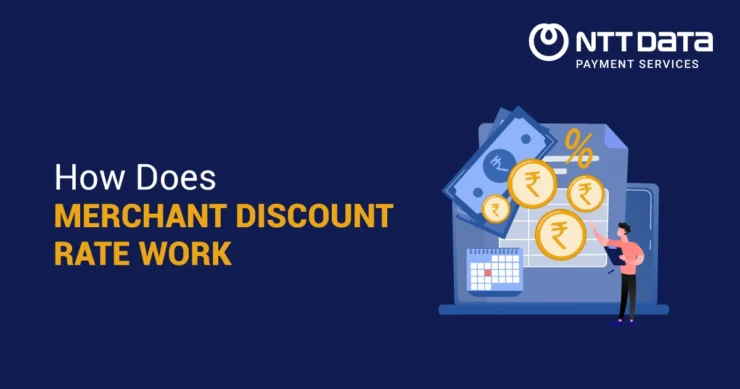
Table of Contents
- 1 What is a Merchant Discount Rate?
- 2 Significance of Merchant Discount Rate
- 3 How Does the Merchant Discount Rate Work?
- 4 Key Features of Merchant Discount Rate
- 5 Benefits of Merchant Discount Rate
- 6 Conclusion
- 7 FAQs
- 8 Common Security Challenges For Mobile Payment Systems
- 9 4 Types Of Biometrics For Payment System
What is a Merchant Discount Rate?
The Merchant Discount Rate work (MDR) is a fee that merchants have to pay to processing companies for handling debit and credit card transactions. This fee is typically a percentage of the transaction amount and can range from 1% to 3%. The Merchant discount rate covers various costs associated with processing payments, including interchange fees, assessment fees, and payment gateway fees.
Significance of Merchant Discount Rate
The Merchant Discount Rate (MDR) is essential in digital payments as it covers the cost merchants pay for processing card transactions, helping them manage expenses. It also generates revenue for payment processors and ensures secure, fraud-resistant transactions.
By enabling card payments, MDR boosts customer convenience and satisfaction. Additionally, it supports technological advancements and ensures compliance with industry regulations like PCI DSS, making transactions more efficient, secure, and reliable for both merchants and customers.
How Does the Merchant Discount Rate Work?
Step 1: Transaction Initiation:
When a customer makes a purchase using a debit or credit card, the transaction is initiated at the point of sale (POS) terminal or online payment gateway.
Step 2: Authorisation:
The payment processor sends the transaction details to the card network, which then forwards the request to the card-issuing bank for authorisation.
Step 3: Approval:
The bank that issued the card verifies the transaction details and either approves or declines the transaction. If approved, the bank sends an authorisation code back to the payment processor.
Step 4: Settlement:
The payment processor facilitates the transfer of funds from the card-issuing bank to the merchant’s account, minus the merchant discount rate fee.
Step 5: Fee Distribution:
The merchant discount rate fee is distributed among the various parties involved in the transaction, including the card-issuing bank, the card network, and the payment processor.
Key Features of Merchant Discount Rate
- Percentage-Based Fee: The Merchant Discount Rate is typically a percentage of each transaction, making it a variable cost that scales with sales volume.
- Inclusive of Various Fees: The Merchant Discount Rate encompasses several components, including interchange fees (paid to the card-issuing bank), assessment fees (paid to the card network), and payment gateway fees (paid to the payment processor).
- Negotiable Rates: Merchants can often negotiate Merchant Discount Rates based on their transaction volume, business type, and relationship with the payment processor.
- Transparency: Payment processors provide detailed breakdowns of Merchant Discount Rate charges, helping merchants understand and manage their payment processing costs.
Benefits of Merchant Discount Rate
- MDR facilitates smooth, streamlined and efficient payment processing, ensuring that transactions are completed quickly and securely.
- By using established payment processors, merchants benefit from advanced security measures that protect against fraud and data breaches, enhancing security.
- Accepting card payments enhances customer convenience, potentially increasing sales and customer satisfaction.
- Payment processors often provide additional services such as analytics, reporting, and customer support, which can help merchants manage their businesses more effectively.
Access the Best Online Payments With Ntt Data Payment Services India.
NTT DATA Payment Services India offers digital payment solutions and services to help businesses accept digital payments securely and reliably.
NTT DATA Payment Services India offers a complete payment solution to advance both your e-commerce and in-store businesses. From online payment gateway and POS machines to IVR payments and Bharat QR Scan and Pay, we ensure convenience and safety for all your payments.
Conclusion
Understanding the merchant discount rate is essential for businesses that accept card payments. By comprehending how merchant discount rates work, their benefits, and key features, merchants can better manage their payment processing costs and enhance their overall financial strategy.
As digital payments continue to grow, staying informed about Merchant Discount Rates and their implications will be essential for business success.
FAQs
1.How is the merchant discount rate fee calculated?
The merchant discount rate fee is calculated as a percentage of each transaction’s total value. For example, if the merchant discount rate is 2% and a customer makes a purchase of Rs 100, the merchant would pay Rs 2 as the merchant discount rate fee.
2.Who receives the merchant discount rate fee?
The merchant discount rate fee is distributed among several parties involved in the transaction process, including the card-issuing bank, the card network and the payment processor.
3.Is it possible for the merchants to negotiate the merchant discount rate?
Yes, merchants can often negotiate the merchant discount rate based on their transaction volume, business type, and relationship with the payment processor. Higher transaction volumes and lower-risk industries may qualify for lower merchant discount rates.
4.Why is the merchant discount rate important for merchants?
Merchant discount rate is important because it represents the cost of accepting card payments. Understanding and managing merchant discount rates helps merchants control expenses, optimise payment processing, and ensure secure transactions.
5.Are there any additional fees associated with the merchant discount rate?
In addition to the merchant discount rate, merchants may incur other fees such as interchange fees, assessment fees, and payment gateway fees. These are typically included in the overall merchant discount rate calculation.


